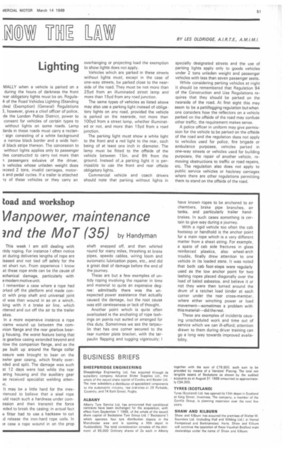toad and workshop
Page 53

If you've noticed an error in this article please click here to report it so we can fix it.
Vlanpower, maintenance
lnd the MoT (35) by Handyman
This week I am still dealing with 'tidy roping. For instance I often notice at during deliveries lengths of rope are leased and not tied off safely for the ixt short run. From experience I know at these rope ends can be the cause of echanical damage, particularly with e modern motive unit.
I remember a case where a rope had orked off the platform and made conct with prop shaft and universal joint id was then wound in as on a winch, king with it a brake air line, which ittened and cut off the air to the trailer akes.
In a more expensive instance a rope :came wound up between the cominion flange and the rear gearbox bear housing, the worst feature being that is gearbox casing extended beyond and ilow the companion flange, and as the pe built up around the flange collar assure was brought to bear on the awler gear casing, which finally over)(Jed and split. The damage was such at 12 days were lost while the rear aring housing and the auxiliary gear se received specialist welding attenin.
It may be a little hard for the inexrienced to believe that a sisal rope uld reach such a hardness under cornession and then transmit the force eded to break the casing; in actual fact e fitter had to use a hacksaw to cut id release the iron-hard rope coils. In le case a rope wound in on the prop shaft snapped off, and then whirled round for many miles, thrashing at brake pipes, speedo cables, wiring loom and automatic lubrication pipes, etc., and did a great deal of damage before the end of the journey.
These are but a few examples of untidy roping involving the repairer in time and material to quite an expensive degree; admittedly there was the unexpected power assistance that actually caused the damage, but the root cause was still carelessness or lack of thought.
Another point which is quite often overlooked is the anchoring of rope lashings on points not suited or arranged for this duty. Sometimes we see the tarpaulin that has one corner secured to the rear number plate bracket, with the tarpaulin flapping and tugging vigorously; I have known ropes to be anchored to air chambers, brake pipe branches, air tanks, and particularly trailer handbrakes. In such cases something is certain to give way during a journey.
With a rigid vehicle too often the cab footstep or handhold is the anchor point for a main rope which is a very different matter from a sheet string. For example, a spate of cab side fractures in glass reinforced plastics, also wheel-arch trouble, finally drew attention to one vehicle in its loaded state. It was noted that both cab foot-steps were regularly used as the low anchor point for two lashing ropes placed diagonally over the load of baled asbestos, and believe it or not they were then turned around the drum of a ratchet load binder at each corner under the rear cross-member, where either winching power or load movement—sometimes a problem with this material—did the rest.
These are examples of incidents causing unscheduled work and time out of service which we can ill-afford; attention drawn to them during driver training can go a long way towards improved availability.




















































































































